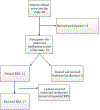Risk-Reducing Salpingectomy Versus Standard Tubal Sterilization: Lessons From Offering Women Options for Interval Sterilization
- PMID: 29505655
- PMCID: PMC6419963
- DOI: 10.14423/SMJ.0000000000000779
Risk-Reducing Salpingectomy Versus Standard Tubal Sterilization: Lessons From Offering Women Options for Interval Sterilization
Abstract
Objectives: In women receiving sterilization, the removal of the entire fallopian tube, a procedure referred to as a risk-reducing salpingectomy (RRS), reduces subsequent ovarian cancer risk compared with standard tubal sterilization procedures. There are limited data on which surgical procedure women will choose when educated about the benefits of an RRS. Our objective was to study the proportion of women desiring sterilization that would choose an RRS.
Methods: This cohort study included women 30 years of age and older with a living biological child who requested laparoscopic sterilization at a tertiary academic hospital. Participants were given a decision aid and offered an RRS or a standard tubal sterilization procedure with titanium clips. The primary outcome was to determine the proportion of women who would choose an RRS. Other outcomes included estimated blood loss and operative time, which was compared between groups, along with complications.
Results: Fourteen of the 18 (78%) women who participated in our study chose RRS. Estimated blood loss and operating time were similar among women who underwent RRS and standard tubal sterilizations. There were no significant complications in either group. The study was ended early based on emerging data and a change in national practice patterns.
Conclusions: Because of the elective nature of sterilization and the complexities of cancer risk reduction, a patient-centered approach is beneficial for sterilization counseling. Our results support offering RRS as an alternative to standard tubal sterilization.
Figures
Similar articles
-
Cost-effectiveness of opportunistic salpingectomy vs tubal ligation at the time of cesarean delivery.Am J Obstet Gynecol. 2019 Jan;220(1):106.e1-106.e10. doi: 10.1016/j.ajog.2018.08.032. Epub 2018 Aug 28. Am J Obstet Gynecol. 2019. PMID: 30170036
-
Extending the safety evidence for opportunistic salpingectomy in prevention of ovarian cancer: a cohort study from British Columbia, Canada.Am J Obstet Gynecol. 2018 Aug;219(2):172.e1-172.e8. doi: 10.1016/j.ajog.2018.05.019. Epub 2018 May 28. Am J Obstet Gynecol. 2018. PMID: 29852159
-
Postpartum Permanent Sterilization: Could Bilateral Salpingectomy Replace Bilateral Tubal Ligation?J Minim Invasive Gynecol. 2016 Sep-Oct;23(6):928-32. doi: 10.1016/j.jmig.2016.05.006. Epub 2016 May 24. J Minim Invasive Gynecol. 2016. PMID: 27234430
-
Risks and Benefits of Salpingectomy at the Time of Sterilization.Obstet Gynecol Surv. 2017 Nov;72(11):663-668. doi: 10.1097/OGX.0000000000000503. Obstet Gynecol Surv. 2017. PMID: 29164264 Review.
-
The Role of Opportunistic Bilateral Salpingectomy vs Tubal Occlusion or Ligation for Ovarian Cancer Prophylaxis.J Minim Invasive Gynecol. 2017 Mar-Apr;24(3):371-378. doi: 10.1016/j.jmig.2017.01.001. Epub 2017 Jan 10. J Minim Invasive Gynecol. 2017. PMID: 28087480 Review.
Cited by
-
Prevention of Epithelial Ovarian Cancer.Cold Spring Harb Perspect Med. 2023 Aug 1;13(8):a038216. doi: 10.1101/cshperspect.a038216. Cold Spring Harb Perspect Med. 2023. PMID: 37137500 Free PMC article. Review.
-
Beyond Sterilization: A Comprehensive Review on the Safety and Efficacy of Opportunistic Salpingectomy as a Preventative Strategy for Ovarian Cancer.Curr Oncol. 2023 Nov 28;30(12):10152-10165. doi: 10.3390/curroncol30120739. Curr Oncol. 2023. PMID: 38132373 Free PMC article. Review.
-
Comparing options for females seeking permanent contraception in high resource countries: a systematic review.Reprod Health. 2021 Jul 20;18(1):154. doi: 10.1186/s12978-021-01201-z. Reprod Health. 2021. PMID: 34284794 Free PMC article.
-
Ovarian cancer prevention through opportunistic salpingectomy during abdominal surgeries: A cost-effectiveness modeling study.PLoS Med. 2025 Jan 30;22(1):e1004514. doi: 10.1371/journal.pmed.1004514. eCollection 2025 Jan. PLoS Med. 2025. PMID: 39883621 Free PMC article.
-
Legal medicine aspects of female sterilization: our experience.Front Med (Lausanne). 2023 Jul 11;10:1198668. doi: 10.3389/fmed.2023.1198668. eCollection 2023. Front Med (Lausanne). 2023. PMID: 37497276 Free PMC article.
References
-
- United Nations. World contraceptive patterns 2013. http://www.un.org/en/development/desa/population/publications/family/con.... Accessed December 29, 2017.
-
- Daniels K, Daugherty J, Jones J, et al. Current contraceptive use and variation by selected characteristics among women aged 15–44: United States, 2011–2013. Natl Health Stat Rep 2015;86:1–14. - PubMed
-
- Society of Gynecologic Oncology. SGO Clinical Practice Statement: salpingectomy for ovarian cancer prevention. https://www.sgo.org/clinicalpractice/guidelines/sgo-clinical-practice-st.... Published November 2013. Accessed December 29, 2017.
-
- Creinin MD, Zite N. Female tubal sterilization: the time has come to routinely consider removal. Obstet Gynecol 2014;124:596–599. - PubMed
-
- Madsen C, Baandrup L, Dehlendorff C, et al. Tubal ligation and salpingectomy and the risk of epithelial ovarian cancer and borderline ovarian tumors: anationwide case-control study. Acta Obstet Gynecol Scand 2015;94:86–94. - PubMed
Publication types
MeSH terms
Grants and funding
LinkOut - more resources
Full Text Sources
Other Literature Sources
Medical

